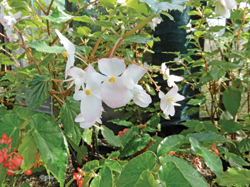Plant of the Month: Begonias
Submitted by Bath Gamma Garden Club
While doing an annual January purge cleaning, Bath Gamma Garden Club member Pam Reitz found an old book on begonias published in 1967 and rediscovered the excitement about begonias. What is so exciting? The types, textures and colors of leaf patterns. Flowers come in all colors except blue. They can grow as tiny single blossoms directly from a stem or as foot-wide clusters of hundreds of tiny flowers. Begonias can be grown indoors or outdoors and some species can even grow in significant shade. There are over 2,000 different plant species in the genus begoniaceae.
Begonias of the semperflorens group, or wax begonias, are frequently grown as bedding plants outdoors. Wax begonias are incredibly attractive and make an excellent choice for mass plantings. They adapt well when brought inside the house for overwintering and can live 4-5 years.
Tuberous begonias are known as the “glorious flower group,” producing the largest flowers at about 2-3 inches and a wide range of colors and shapes. Tuberous begonias are frequently used as container plants and the pendula type is great for hanging baskets, bringing color to the shade garden. Unlike other begonias, they require a dormant period. After the first frost, the tubers should be lifted, dried and stored in a cool dry place over winter and then restarted indoors in spring.
Rhizomatous types of begonias display an endless variety of leaf shape, color and texture. They are known for colorful intricate patterned leaves with a compact growth habit and can range from miniature to large. The leaves can be hairy, round and shiny or even star shaped. They produce a mass of small blooms in spring.
Considering that begonias occur in subtropical and tropical moist climates of Central and South America, Africa and southern Asia, they require warm temperatures ranging from 55 to 85 degrees Fahrenheit and benefit from humidity. Most are forest understory plants that require bright shade, and a few will tolerate bright sun (the semperflorens group). They require a well-drained growing medium, which is slightly acidic. Balanced moisture is critical. Water thoroughly when the top of the medium becomes dry to the touch. Growers prefer to fertilize at about one-fourth the recommended rate. Pruning should be done through soft pinching in late winter or early spring when new growth appears.
If you like variety, then begonias are your go-to plant. It has been suggested that a group of plants makes a better display than a single plant. The American Begonia Society is a good reference point for more specific details on various cultivars. ∞
Photo: Begonias can be grown indoors or outdoors. Photo by Pam Reitz.

